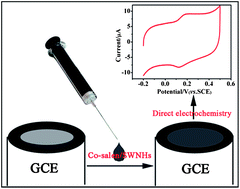Electrochemical sensing platform based on Schiff-base cobalt(ii)/single-walled carbon nanohorns complexes system†
Abstract
Single-walled

* Corresponding authors
a
State Key Laboratory of Electroanalytical Chemistry, Changchun Institute of Applied Chemistry, Chinese Academy of Sciences, Changchun, Jilin 130022, People's Republic of China
E-mail:
jltang@ciac.jl.cn
Fax: +86-431-85262734
Tel: +86-431-85262734
b Graduate University of the Chinese Academy of Sciences, Beijing, People's Republic of China
Single-walled

 Please wait while we load your content...
Something went wrong. Try again?
Please wait while we load your content...
Something went wrong. Try again?
B. Lu, Z. Zhang, J. Hao, G. Xu, B. Zhang and J. Tang, Anal. Methods, 2012, 4, 3580 DOI: 10.1039/C2AY25940K
To request permission to reproduce material from this article, please go to the Copyright Clearance Center request page.
If you are an author contributing to an RSC publication, you do not need to request permission provided correct acknowledgement is given.
If you are the author of this article, you do not need to request permission to reproduce figures and diagrams provided correct acknowledgement is given. If you want to reproduce the whole article in a third-party publication (excluding your thesis/dissertation for which permission is not required) please go to the Copyright Clearance Center request page.
Read more about how to correctly acknowledge RSC content.
 Fetching data from CrossRef.
Fetching data from CrossRef.
This may take some time to load.
Loading related content
